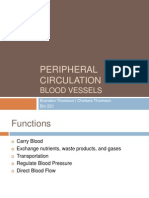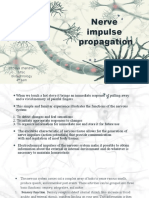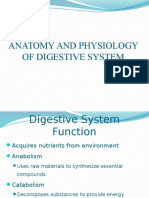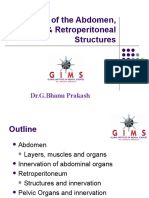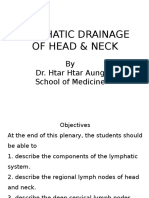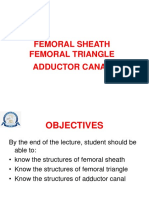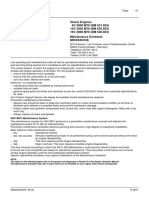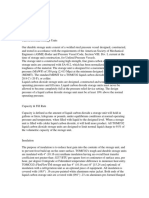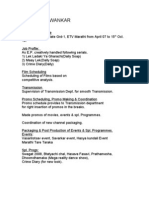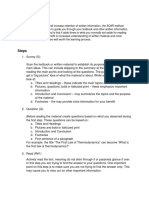Anatomy of Circulatory System
Anatomy of Circulatory System
Uploaded by
Lina WijayaCopyright:
Available Formats
Anatomy of Circulatory System
Anatomy of Circulatory System
Uploaded by
Lina WijayaOriginal Description:
Copyright
Available Formats
Share this document
Did you find this document useful?
Is this content inappropriate?
Copyright:
Available Formats
Anatomy of Circulatory System
Anatomy of Circulatory System
Uploaded by
Lina WijayaCopyright:
Available Formats
LINA-PANDU-MARTHIN-MARSELLA-BOBY
ANATOMY OF CIRCULATORY
SYSTEM
The components
Vessels
Arteries
Veins
Capillaries
HEART
BLOOD
Two Circuit Path
Pulmonary circuit
The right side of the
heart the lungs the
left side of the heart.
Systemic circuit
The pathway between
the left and right sides of
the heart.
Circulatory routes
Simply put: heartarteriesarterioles
capillariesvenulesveinsheart
In a portal system blood passes through two consecutive
capillary networks before returning to the heart
An anastomosis is a point where two veins or arteries
merge with each other
Venous anastomosis provide alternative routes of
drainage from an organ, so blockage of a vein is seldom
life threatening
Arterial anastomosis is where two arteries merge and
provide collateral (alternate) routes of blood supply
Mediastinum
The mediastinum : superior
and inferior
The inferior mediastinum
subdivided by the pericardium
into anterior, middle, and
posterior parts.
The pericardium and its
contents (the heart and roots
of its great vessels) constitute
the middle mediastinum
The Cardiovascular System
1
HEART
The heart pumps blood into large vessels
that branch into smaller ones leading into the organs.
Materials are exchanged by diffusion between the
blood and the interstitial fluid bathing the cells.
2. Blood Vessels -A network of tubes
Arteriesarterioles move away from the heart
Elastic Fibers
Circular Smooth Muscle
Capillaries where gas exchange takes place.
One cell thick
Serves the Respiratory System
VeinsVenules moves towards the heart
Skeletal Muscles contract to force blood back
from legs
One way values
When they break - varicose veins form
2
Arteries
Arteries are more muscular than veins
3 types:
Conducting or elastic arteries-largest, expand
when ventricles contract (aorta is example)
Distributing or muscular arteries-distribute blood
to specific organs (brachial artery is example)
Resistance or small arteries-vary in location and
number, smallest are arterioles
Contain thin layer of endothelium designed for diffusion (tunica
interna)
Location for the exchange of gases
Few located in tendons, ligaments, and none in cartilage,
epithelium, and cornea and lens of eye
Organized into capillary beds which increase the total surface area
and slows blood flow
Veins and venules
Venules are small veins that connect to capillaries
Venous sinuses- are veins with very thin walls, large
lumens, and no smooth muscle (coronary sinus, dural
sinus)
Veins have a much lower blood pressure than arteries
(usually about 10 mmHg)
Veins have thinner walls and collapse when empty
Veins can expand to accommodate more blood than
arteries (considered to be blood reservoirs)
Upward flow of blood depends in part on the massage
action of skeletal muscle and on the presence of one
way venous valves that keep blood from dropping down
again when muscle relaxes
These valves are not present in small veins and very
large veins, veins of the ventral body cavity, and veins of
the brain
Varicose veins are caused by pooling of the blood and
stretching of the vein
Arterial pulse
Can palpate the pulse at:
Temporal artery, facial artery, carotid
artery, brachial artery, radial artery,
femoral artery, popliteal artery, posterior
tibial artery, and dorsalis pedis artery
Pulse points
Paths of Circulation
1. Pulmonary circulation-begins with
pulmonary trunkpulmonary arteries-
--lobar arteries in lungs----capillary
beds---venules---veins---pulmonary
veins---left atrium
2. Systemic circulation-blood flow to rest of
body, often named for location
Pathway of Circulation
Oxygen-poor blood
draining from the body
through veins into the
superior and inferior vena
cava flows to the right
atrium, through the
tricuspid valve, and into
the right ventricle.
As the right ventricle
contracts, oxygen-poor
blood passes through the
pulmonary valve into the
pulmonary arteries and
on to the lungs to receive
oxygen.
Pulmonary circuit
Arteriole
Venule
Tissue cells
Vein
Artery
capillaries
Capillaries
Systemic circuit
composed of vessels that lead from the
heart to all body parts (except the
lungs) and back to the heart
includes the aorta and its branches
includes the system of veins that
return blood to the right atrium
Pathway of Circulation
Oxygen-rich blood from
the lungs enters the heart
through the pulmonary
veins, passing into the left
atrium.
Then through the mitral
valve to the left ventricle.
Contraction of the left
ventricle forces blood
through the aortic valve
into the aorta.
Various arteries branch off
from the aorta to supply
blood to all parts of the
body.
Branches of Aorta
Ascending aorta- arises from the left ventricle
Branches into coronary arteries which supply the heart
muscle
Aortic arch gives off 3 branches: brachiocephalic trunk,
left common carotid artery, left subclavian artery
brachiocephalic trunk which splits into right common carotid
artery (supplies right side of head and neck), and right
subclavian artery (supplies right upper limb and some of thorax)
Descending aorta -passes downward behind the heart,
called thoracic aorta above the diaphragm and
abdominal aorta below it. It ends when it forks into left
and right common iliac arteries
Arteries to Head and Neck and
Brain
Branches of subclavian and common carotid
arteries supply neck, head, and brain
Vertebral arteries arise from subclavian arteries
and supply vertebrae and their ligaments and
muscles
Vertebral arteries unite to form basilar artery in
brain, and terminates by branching into two
posterior cerebral arteries (these help form
Circle of Willis)
Carotid arteries
Left and right common carotid arteries ascend deeply in neck and divide
into external and internal carotid arteries
External carotid artery gives off branches that supply neck, face, jaw, scalp,
and base of skull
Internal carotid artery follows a deep pathway to the base of the skull and
enters cranial cavity and provides a major blood supply to the brain
Circle of Willis
Arteries of Shoulder and Upper Limb
Subclavian artery continues into limb and becomes the axillary
artery (supplies axilla, and chest wall)
Axillary artery becomes the brachial artery (humerus to elbow)
Brachial artery gives rise to deep brachial artery which supplies
triceps muscle
Brachial artery divides at elbow into ulnar artery and radial artery
Arteries to Thoracic and Abdominal
wall
Subclavian artery branches into internal thoracic
artery which gives off two branches called
anterior intercostal arteries
Posterior intercostal arteries arise from thoracic
aorta
Branches from internal thoracic artery and
external iliac arteries supply anterior abdominal
wall
Paired vessels from abdominal aorta (phrenic
and lumbar arteries) supply posterior and lateral
abd. wall
Arteries to Pelvis and Lower Limb
Abdominal aorta divides into common iliac arteries at
pelvic brim
This divides into internal iliac artery (pelvic muscle,
viscera, gluteal muscles, and external genitalia)
Also divide into external iliac artery which is the main
blood supply to the lower extremity
External iliac artery becomes the femoral artery
Femoral branches into popliteal artery (behind knee)
Popliteal artery divides into anterior and posterior tibial
artery
Anterior tibial artery becomes the dorsalis pedis artery
which supplies the instep and toes
Posterior tibial artery descends beneath the calf muscle
Largest branch from posterior tibial artery is the fibular
artery which travels along the fibula
Abdominal aorta and major branches
The gastric, common hepatic, and splenic arteries are part of the
celiac trunk.
(splenic artery supplies spleen, gastric artery-stomach, renal artery-
kidney, common hepatic artery-liver)
ANATOMY : KIDNEY
( ANTERIOR VIEW )
ANATOMY : INTRARENAL ARTERIES
Venous system
Returns blood to heart after gas, nutrients,
and wastes are exchanged between blood
and body cells
The veins from all systemic areas of the
body merge into either the superior vena
cava or inferior vena cava
Major veins
Veins of Head, Neck, and Brain
External jugular veins drain blood from face, scalp, and superficial areas of
neck
Empty into the right and left subclavian veins at base of neck
Internal jugular veins drain brain, parts of face and neck and join subclavian
veins
Union of internal jugular vein and subclavian veins forms the
brachiocephalic veins on each side
These merge in mediastinum and give rise to superior vena cava
Veins from upper limb and shoulder
Main vessels of superficial network are basilic vein and
cephalic vein
Basilic vein ascends along medial side of arm until it
joins the brachial vein. They both unite to form the
axillary vein
Cephalic vein ascends along the lateral side of the arm
and joins the axillary vein at the shoulder. This forms the
subclavian vein
A median cubital vein is located at the bend of the elbow
and is used in venipuncture Deep veins parallel arteries
and are given the same names
Radial vein, ulnar vein, brachial vein, and axillary vein
Deep veins of arm
Veins of the abdominal and thoracic
walls
Veins from abdominal viscera originate in capillary
networks of stomach, intestines, pancreas, and spleen
and carry blood into the hepatic portal vein to the liver
From there blood enters hepatic sinusoids
Tributaries of this hepatic portal system include: right
and left gastric veins (stomach), superior mesenteric
vein (small intestine, ascending and transverse colon),
splenic vein (spleen), inferior mesenteric vein
(descending colon, sigmoid colon, rectum)
After entering hepatic sinusoids the blood travels into
hepatic veins then into inferior vena cava
Hepatic Portal System
Functions to filter deoxygenated but NUTRIENT RICH
blood received from digestive system to get rid of toxins
and bacteria BEFORE it is distributed to rest of body
Liver receives venous blood from digestive organs via
portal vein
Portal vein divides into 2 branches (left and right) which
enter liver
These keep branching until they form the hepatic
sinusoids within the lobes of the liver
The hepatic sinusoids unite to form the hepatic veins
which exit the liver and enter the inferior vena cava
Hepatic portal vein
Veins that drain abdominal viscera
ANATOMY : INTRARENAL ARTERIES
ANATOMY : RENAL ARTERY & VEIN
Veins from lower limb and pelvis
Deep veins of leg have names that correspond to arteries they
accompany
These include anterior and posterior tibial veins
At knee these merge to form popliteal vein
This continues through thigh as the femoral vein, which becomes
the external iliac vein
Superficial veins of foot, leg, thigh connect to form a complex
network beneath the skin and drain into 2 major trunks: the great
and small saphenous veins
Small saphenous vein passes upward behind lateral malleolus and
eventually joins the popliteal vein
The great saphenous vein is the longest vein in the body. It passes
along the medial side of the leg and thigh and eventually joins the
femoral vein (use this one in coronary bypass surgery)
Vessels leading to internal iliac vein drain the reproductive organs,
urinary, and digestive
Internal iliac veins originate deep in pelvis and ascend to unite with
the right and left iliac veins to form common iliac veins
These merge to produce the inferior vena cava at the 5
th
lumbar
vertebra
Veins that drain the lower extremity
THANK YOU
You might also like
- 1) Femal Pelvis&fetal SkullDocument36 pages1) Femal Pelvis&fetal SkullHayder MuthanaNo ratings yet
- Cardiovascular System: More Than Just The HeartDocument34 pagesCardiovascular System: More Than Just The HearteliseudesafateNo ratings yet
- Peripheral CirculationDocument27 pagesPeripheral CirculationRachel ThomsonNo ratings yet
- The-Skull by Dr. Phan SandethDocument65 pagesThe-Skull by Dr. Phan SandethTith Sunny100% (2)
- Femoral Region, Anterior and Medial Compartments of The ThighDocument49 pagesFemoral Region, Anterior and Medial Compartments of The ThighNolanNo ratings yet
- Anatomy - Nerves of AbdomenDocument7 pagesAnatomy - Nerves of AbdomenMuhammad Junaid AnisNo ratings yet
- Colorectal MalignancyDocument108 pagesColorectal MalignancySatishht SatishNo ratings yet
- Propagation of Nerve ImpulseDocument42 pagesPropagation of Nerve ImpulseRe UpNo ratings yet
- Lec6 - Circulatory SystemDocument4 pagesLec6 - Circulatory SystemEloisa Trina GenerosoNo ratings yet
- Anatomy of The NeckDocument34 pagesAnatomy of The NeckAsma AlamoudiNo ratings yet
- Bone Joint Cartilage PowerpointDocument81 pagesBone Joint Cartilage PowerpointChevie Wiseman100% (1)
- Peritoneum: General FeaturesDocument92 pagesPeritoneum: General Featurestuhinsingh100% (1)
- Anatomy and Physiology No.1Document38 pagesAnatomy and Physiology No.1Ken Marco SalipsipNo ratings yet
- Human Physiology: The Nervous SystemDocument29 pagesHuman Physiology: The Nervous Systemzandrex delunaNo ratings yet
- Femoral Triangle 1Document20 pagesFemoral Triangle 1USAMA AHMEDNo ratings yet
- Anatomy and Physiology of Digestive SystemDocument30 pagesAnatomy and Physiology of Digestive SystemAiron Vince Peralta CalicaNo ratings yet
- Hypophysis CerebriDocument21 pagesHypophysis CerebriAli Akand AsifNo ratings yet
- Dr. Reynaldo V. Lopez Senior Lecturer Department of AnatomyDocument55 pagesDr. Reynaldo V. Lopez Senior Lecturer Department of AnatomyMohammad AliNo ratings yet
- The Lymphatic System and Lymphoid Organs and TissuesDocument46 pagesThe Lymphatic System and Lymphoid Organs and Tissuessanananaa100% (1)
- DuodenumDocument47 pagesDuodenumAarish KanwatNo ratings yet
- Anatomy of Urinary Bladder and UrethraDocument16 pagesAnatomy of Urinary Bladder and UrethraAmalina ZolkefleeNo ratings yet
- Types of NervesDocument15 pagesTypes of NervesElijah WilsonNo ratings yet
- Musculature and Fascia: Station 1: The Anterior Abdominal WallDocument10 pagesMusculature and Fascia: Station 1: The Anterior Abdominal WallAlia SahniNo ratings yet
- Anatomy and Physiology of Nervous SystemDocument91 pagesAnatomy and Physiology of Nervous SystemSanhati Ghosh Banerjee100% (2)
- Femoral TriangleDocument4 pagesFemoral TriangleHassan MohamedNo ratings yet
- Cns RadDocument31 pagesCns RadatefmaboodNo ratings yet
- Femoral Nerve: S.Gokul B.P.T. K.M.C.H. College of Physiotherapy, CoimbatoreDocument18 pagesFemoral Nerve: S.Gokul B.P.T. K.M.C.H. College of Physiotherapy, CoimbatoreHevin Gokul100% (1)
- Spinal NervesDocument15 pagesSpinal NervesPrachNo ratings yet
- (K33) Cranial and Spinal NerveDocument68 pages(K33) Cranial and Spinal NerveCut Putri Astritd Adelina100% (1)
- Body TissuesDocument29 pagesBody TissuesPurplesmilezNo ratings yet
- Muscle Spindle: By-Dr. Pravin P. Gawali Ii MPT KCPTDocument27 pagesMuscle Spindle: By-Dr. Pravin P. Gawali Ii MPT KCPTPravin Gawali100% (1)
- Anatomy - Abdomen and PelvisDocument46 pagesAnatomy - Abdomen and PelvisDr.G.Bhanu PrakashNo ratings yet
- Lecture Notes On The Muscular SystemDocument46 pagesLecture Notes On The Muscular SystemDennis Nabor Muñoz, RN,RM100% (1)
- Clinical Anatomy of The Esophagus and StomachDocument82 pagesClinical Anatomy of The Esophagus and StomachmackieccNo ratings yet
- Anatomy of The Intercostal SpaceDocument17 pagesAnatomy of The Intercostal Spacelovelyc95100% (1)
- Lecture 19 - Vessels and CirculationDocument67 pagesLecture 19 - Vessels and CirculationSasikala MohanNo ratings yet
- Anatomy of The Respiratory System 1Document8 pagesAnatomy of The Respiratory System 1Grace Noviyanthi SinambelaNo ratings yet
- Abdominal Wall Learning ObjectivesDocument7 pagesAbdominal Wall Learning ObjectivesMadison KommorNo ratings yet
- Composition & Functions of BloodDocument15 pagesComposition & Functions of BloodShahroze AlamNo ratings yet
- Lymphatic Drainage of Head and NeckDocument19 pagesLymphatic Drainage of Head and NeckKelly Yeow100% (1)
- The Human Renal SystemDocument15 pagesThe Human Renal SystemChuche SustentoNo ratings yet
- Lecture 23 - The Urinary SystemDocument46 pagesLecture 23 - The Urinary SystemIhab MoustafaNo ratings yet
- Lymphatic SystemDocument10 pagesLymphatic SystemPasipanodya MuzendaNo ratings yet
- Respiratory PhysiologyDocument37 pagesRespiratory PhysiologyclarisseNo ratings yet
- Anatomy of The Digestive System and Circulatory SystemDocument17 pagesAnatomy of The Digestive System and Circulatory SystemRafael Quieta Claro Jr.No ratings yet
- Stretch ReflexDocument18 pagesStretch ReflexRonald Susanto BudhyNo ratings yet
- Anterior & Medial Compartment of ThighDocument25 pagesAnterior & Medial Compartment of ThighnasibdinNo ratings yet
- 8.1 The Nervous System and Nerve ImpulsesDocument60 pages8.1 The Nervous System and Nerve ImpulsesAmber Michaels100% (1)
- Cranial Nerves and Its ExaminationDocument136 pagesCranial Nerves and Its ExaminationNileshNo ratings yet
- 7th Week Femoral Sheath, Femoral Triangle and Adductor CanalDocument17 pages7th Week Femoral Sheath, Femoral Triangle and Adductor CanalShah NawazNo ratings yet
- The Nervous System: Na ShaoDocument79 pagesThe Nervous System: Na ShaoArvindhanNo ratings yet
- Introduction To Histology and Epithelium TissueDocument48 pagesIntroduction To Histology and Epithelium TissuejabirNo ratings yet
- Male Reproductive Organs 2018Document80 pagesMale Reproductive Organs 2018yasrul izad100% (1)
- Anatomy of Urinary SystemDocument43 pagesAnatomy of Urinary SystemIrfan Ali JunejoNo ratings yet
- Respiratorysystem 120105050542 Phpapp01Document43 pagesRespiratorysystem 120105050542 Phpapp01Buuvee Be100% (1)
- Lower Limb NervesDocument30 pagesLower Limb NervesSamo BeainoNo ratings yet
- Anatomy and Physiology Ii SMS 1224: Norhayati Ismail NOV 2011Document50 pagesAnatomy and Physiology Ii SMS 1224: Norhayati Ismail NOV 2011Shirley LourdesNo ratings yet
- Cardiovascular System PDFDocument149 pagesCardiovascular System PDFGayathri S100% (1)
- Anatomy of The Cardiovascular SystemDocument78 pagesAnatomy of The Cardiovascular SystemdanielnawethiNo ratings yet
- Grade Does Not Define You. You Bukan Telur AyamDocument7 pagesGrade Does Not Define You. You Bukan Telur AyamAinulNo ratings yet
- There Are 8 Courses in This Professional Certificate: Introduction To Cybersecurity Tools & Cyber AttacksDocument3 pagesThere Are 8 Courses in This Professional Certificate: Introduction To Cybersecurity Tools & Cyber AttacksGUESHNo ratings yet
- Data Sheets Mobrey Product ECatalogue 2015 Edition en 67194Document220 pagesData Sheets Mobrey Product ECatalogue 2015 Edition en 67194Basil M. IkhleifNo ratings yet
- Diesel Engines 8V 2000 M70 (BM 531.923) 12V 2000 M70 (BM 535.923) 16V 2000 M70 (BM 536.923) Maintenance Schedule M050540/02EDocument4 pagesDiesel Engines 8V 2000 M70 (BM 531.923) 12V 2000 M70 (BM 535.923) 16V 2000 M70 (BM 536.923) Maintenance Schedule M050540/02EsxturboNo ratings yet
- Quality Living Conditions and The Boarding Preferences of UMDocument9 pagesQuality Living Conditions and The Boarding Preferences of UMQUEENNIE PROVIDANo ratings yet
- Zener Diode TesterDocument3 pagesZener Diode TesterVijay MirjeNo ratings yet
- STS2 - Intellectual RevolutionsDocument42 pagesSTS2 - Intellectual RevolutionsFritzzie ManalangNo ratings yet
- Practical ResearchDocument33 pagesPractical ResearchronelNo ratings yet
- Structural Framework Workflows For Petrel 2018Document207 pagesStructural Framework Workflows For Petrel 2018卢郑鹏No ratings yet
- Complete Create Space How To Manage Time and Find Focus Productivity and Success Derek Draper PDF For All ChaptersDocument52 pagesComplete Create Space How To Manage Time and Find Focus Productivity and Success Derek Draper PDF For All Chaptersbinitsozari100% (2)
- Puyou Brief Introduction-2016.05.31Document35 pagesPuyou Brief Introduction-2016.05.31sanmiteNo ratings yet
- Engine Service Tool Reference ListDocument4 pagesEngine Service Tool Reference ListTec Electrónica DieselNo ratings yet
- CO2 StorageDocument8 pagesCO2 Storagecryovikas1975No ratings yet
- Essential Engineering Calculations Series Heat Transfer Applications For The Practicing Engineer 1 To 60Document60 pagesEssential Engineering Calculations Series Heat Transfer Applications For The Practicing Engineer 1 To 60Muh Andika Pratama WarisNo ratings yet
- Muhammad Saeed Iqbal P (104-132)Document29 pagesMuhammad Saeed Iqbal P (104-132)International Journal of Management Research and Emerging SciencesNo ratings yet
- Problem of RehologyDocument4 pagesProblem of RehologyShagufta AfaqueNo ratings yet
- Dilip W. Bawankar: Work ExperienceDocument3 pagesDilip W. Bawankar: Work ExperienceHitesh SuryawanshiNo ratings yet
- SQ4R MethodDocument3 pagesSQ4R MethodMuhammad ShahrozNo ratings yet
- Fish FarmingDocument25 pagesFish FarminghenchudiNo ratings yet
- (One Sheeter) Migrate To Performanace MaxDocument5 pages(One Sheeter) Migrate To Performanace MaxRicardo TapiaNo ratings yet
- Free Energy GeneratorDocument18 pagesFree Energy GeneratorDeepakRajKurrey60% (5)
- Fyp Final ReportDocument86 pagesFyp Final ReportZeeshan HameedNo ratings yet
- EDRADAN - Multilingualism in The ClassroomDocument4 pagesEDRADAN - Multilingualism in The ClassroomFriedrich Carlo Jr. EdradanNo ratings yet
- Conflict Resolution and Management Module 4 AssignmentDocument7 pagesConflict Resolution and Management Module 4 AssignmentZrii NaturalGreenWellness100% (1)
- 39-Cable ScheduleDocument47 pages39-Cable ScheduleJason SecretNo ratings yet
- Lab 7 SolutionDocument8 pagesLab 7 Solutionf20221197No ratings yet
- Flex 24v 2022 Catalog Pms DigitalDocument100 pagesFlex 24v 2022 Catalog Pms DigitalCuong CaoNo ratings yet
- Mud Pump Consumables - enDocument24 pagesMud Pump Consumables - enflasher_for_nokia100% (1)
- Techniques of Chromosome Manipulation in FishDocument28 pagesTechniques of Chromosome Manipulation in FishKanjoya KaranjaNo ratings yet
- Seductress GameDocument14 pagesSeductress GameBarbaraNo ratings yet


